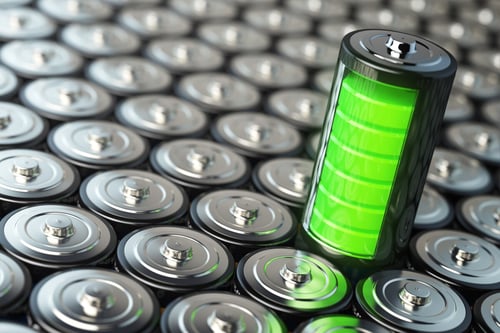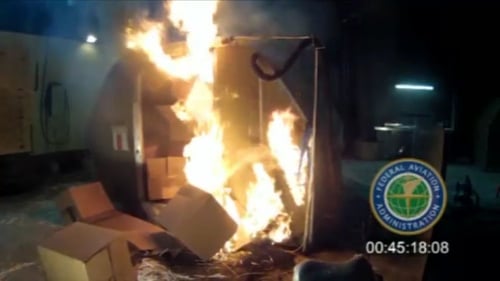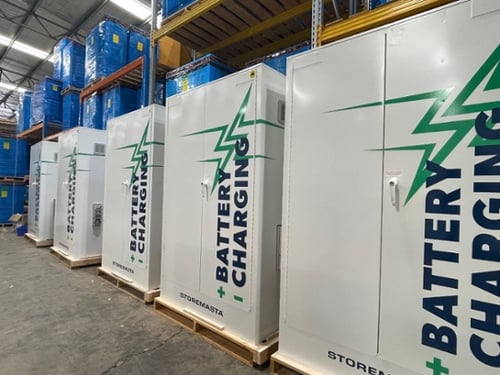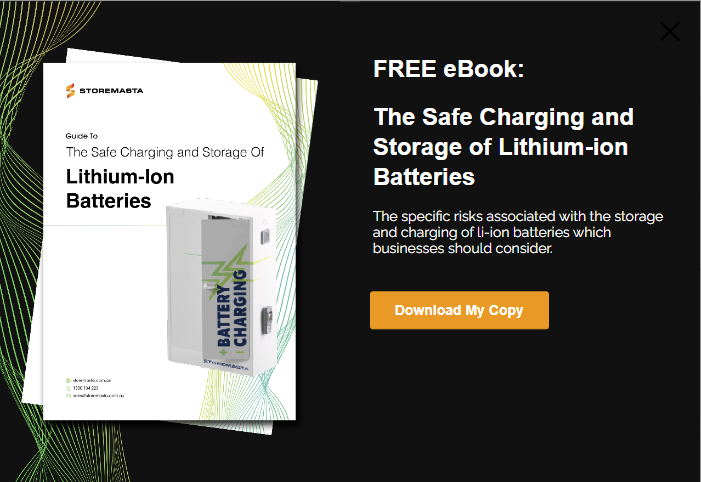Lithium-ion batteries are a modern innovation that have made their way into almost every workplace and household. Whether they’re the battery that powers your phone or the power source for your electric drill, lithium-ion batteries are regarded as an efficient and effective rechargeable battery. However, there are serious risks associated with the use of lithium-ion batteries. In this blog, we’ll explain what lithium-ion batteries are, how they work and how you can control the risk of lithium-ion battery fires, explosion and thermal runaway.
What are Lithium-Ion Batteries?
As we’ve touched on, lithium-ion batteries are a rechargeable battery that’s commonly found in technology, devices and electrical equipment.
You may find lithium-ion batteries in:
- Mobile phones
- Laptops
- Tablets
- Electric vehicles
- Electric bikes
- Marine craft
- Power tools
- Industrial robots
- Drones
- Medical devices
- Production equipment
- Solar energy storage
Unlike disposable batteries, which add to the growing waste problem, lithium-ion batteries are designed to be recharged. They offer high-capacity power storage which delivers excellent performance, therefore making lithium-ion a popular battery choice for commercial and industrial enterprises.
![]() Lithium-ion batteries are found in mobile phones, laptops, tablets, electric vehicles and power tools.
Lithium-ion batteries are found in mobile phones, laptops, tablets, electric vehicles and power tools.
When Were They Developed?
While the technology for rechargeable batteries may not be new, lithium-ion batteries have only been mass produced since 1991. The battery was originally developed by chemist M Stanley Whittingham who determined that you could create energy storage using lithium cells. By 1979, three scientists (including John Goodenough) separately attempted to develop the lithium cobalt dioxide battery – which became crucial in the development of the lithium-ion battery.
In the mid 1980s, Akira Yoshino created the prototype which used lithium ion and lithium cobalt dioxide as the electrodes. Just six years later, lithium-ion batteries hit the market — mass produced by Japanese companies Sony and Asahi Kasei.
It’s also interesting to note that Akira Yoshino, John Goodenough and Stanley Whittingham were awarded the Nobel Prize for chemistry in 2019 for their development of the lithium-ion battery.
So, How Do Lithium-Ion Batteries Work?
Non-rechargeable batteries work differently to rechargeable batteries such as lithium-ion. The non-rechargeable batteries produce positively-charged particles (ions) and negatively-charged electrons. When the battery is using power, the ions will move through the battery while the electrons travel to the circuit. However, this process can’t be reversed – and the ions can only travel in the one direction.
When lithium-ion batteries are being charged, the ions move from the cathode to the anode through the electrolyte fluid. When these batteries are using energy, a discharge circuit forms between the anode and the cathode, with the ions in the anode moving to the cathode to provide energy for the device or equipment.

Your lithium-ion batteries are designed to be repeatedly recharged over a period of years.
When you have a rechargeable lithium-ion battery, the process of chemical reaction is reversible. The process can be repeated many times over a period of many years – which makes rechargeable batteries, such as lithium-ion batteries, a cost-effective battery solution with a long lifespan.
What are the Dangers Associated With the Charging of Lithium-Ion Batteries?
While this type of battery is a common site in offices, warehouses, industrial sites and commercial premises, there are serious risks associated with its use.
Like to know more about Li-ion battery safety?
Lithium-ion Battery Fires
Lithium-ion battery fires can occur when batteries are being charged. These fires are not easily contained and are self-sustaining. As these batteries contain a flammable electrolyte fluid, they may become pressurised — and therefore dangerous — in a range of circumstances.
Fires may occur if the lithium-ion battery has:
- Suffered impact damage
- Aged and deteriorated in quality
- A manufacturing flaw
- Been charged or stored in extreme cold or heat
- Overcharged
Thermal Runaway
Thermal runaway is another risk when using and recharging lithium-ion batteries. This occurs through thermal or mechanical failures – such as a battery being overcharged, over-discharged or overheated.
When this process occurs, it results in high temperatures that produce an exothermic decomposition of the battery cell — which leads to the battery rupturing and creating a thermal explosion.

Lithium-ion battery fires can occur if the battery has been damaged, overcharged or kept in extreme temperatures.
Basic Safety Measures
To reduce the risk of fire and explosion, there are many things you can do to ensure your lithium-ion batteries are stored and charged in a safe manner.
Ensure Your Battery Charger Meets Australian Standards
One of the key things you can do is to ensure that your battery chargers meet the requirements of the national Electrical Equipment Safety System. Not all battery chargers – including those bought from overseas manufacturers – will conform with these requirements. Look out for a regulatory compliance mark (RCM) to ensure that your lithium-ion battery charger is approved for use in Australia.
Safeguard Your Batteries Against Overcharging
As lithium-ion batteries can be responsible for devastating fires and explosions, it’s important that you take steps to prevent your battery from being overcharged. You shouldn’t leave batteries unattended while they’re charging and ensure that you turn the battery off once it’s fully charged. Don’t charge your lithium-ion batteries if you’re leaving the premises or going to bed.
Storing and Charging Lithium-Ion Batteries in the Workplace
If your technology or equipment relies on lithium-ion batteries, it’s important to consider how you can safely store and charge these batteries. One of the safest ways to do this in the workplace is by installing a battery charging cabinet.

Battery charging cabinets provide an array of risk control measures to reduce the risk of lithium-ion battery fires.
A battery charging and storage cabinet, such as our Storemasta model, offers a range of risk control measures to assist with:
- Spill containment – in the event of a battery leaking while in storage
- Temperature control – to prevent thermal runaway or fire
- Electrically certified – for safe and compliant battery charging
Features of a Compliant Battery Charging Cabinet
To provide the above-mentioned risk control measures, battery charging cabinets should have the following features:
- Double-walled sheet steel construction - for the walls, floor, door and roof; to assist with impact damage and thermal protection
- A space of at least 40 mm between walls – for thermal protection
- Self-contained spill containment sump – to contain leaks and spills
- Self-closing, close fitting doors – to assist with heat protection
- Sealed gaps around doors and into the space between walls – to prevent heat radiation and the spread of flames
- Fan with grill and flex – to keep the batteries and electrical work within the cabinet at a safe temperature
- RCD Protection – for protection against fatal electric shock
Each unit should also be individually certified by a qualified electrician to ensure the electrical safety of the cabinet and its battery charging systems.
Your battery charging cabinet provides a safe space for your lithium-ion batteries to be stored and recharged.
How are You Storing and Charging Your Batteries?
If you’re one of the thousands of Australian businesses that runs on lithium-ion battery power, make sure that you’re taking precautions to reduce the risk of fire, explosion and thermal runaway. As we’ve explained, a key consideration when storing and charging lithium-ion batteries is to make sure that they’re never overcharged, they’re kept away from extreme temperatures and are safe from impact damage. You should also ensure that lithium-ion batteries are only charged with a battery charger that meets Australian Safety Standards.
Even though lithium-batteries are a commonly used battery, they are still recognised as Class 9 Miscellaneous Dangerous Goods. Therefore, it’s crucial that you understand how to handle, store and charge these batteries to reduce risk in your workplace. If you’d like to learn more about controlling risk, we have an eBook that can help. Guide to the Safe Charging and Storage of Lithium-ion Batteries will highlight simple steps that you can take to improve safety in your battery handling and storage areas. We'll also introduce you to our 4-step risk control methodology, IDENTIFY – ASSESS – CONTROL – SUSTAIN. This methodology can be easily applied to any workplace, so you can better manage the chemical risks posed by lithium-ion batteries and other classes of Dangerous Goods.

Living life by the 4 C’s of marketing – communication, coffee, compliance… and more coffee – Leisa Andersen is Storemasta’s Content Marketing Manager. When she’s not writing, you’ll find her enjoying all the good things in life, including shopping, travel and gluten free donuts.
